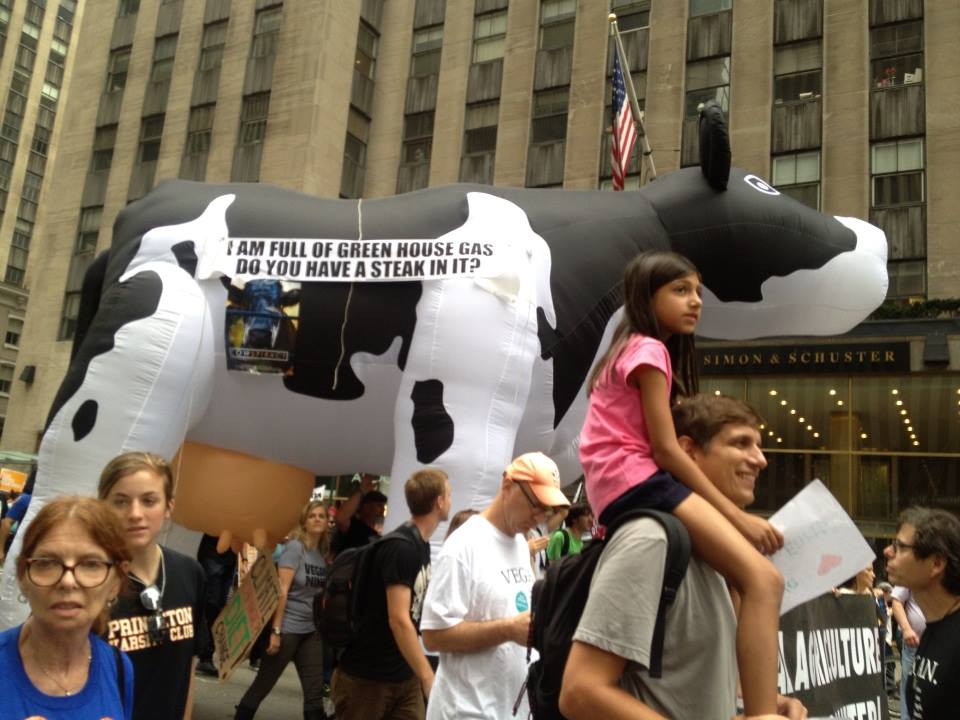 To build an effective animal protection movement, we need to find allies across other social justice movements. Adding further rationale to our cause (i.e. the massive environmental impact of animal agriculture) significantly strengthens our advocacy, and the more voices we can draw in as support, the better.
To build an effective animal protection movement, we need to find allies across other social justice movements. Adding further rationale to our cause (i.e. the massive environmental impact of animal agriculture) significantly strengthens our advocacy, and the more voices we can draw in as support, the better.
As animal advocates, we all have that friend who unplugs their appliances to avoid vampire losses, rinses and polishes every item for recycling, invests in electric vehicles for transportation or spends extra on their utility bill to ensure their power comes from renewable energy while continuing to consume animal products as if these choices have no effect on the environment.
The fact is, environmentalists are passionate about their cause, and they make great sacrifices to make a difference in the world we share. The Climate March is the perfect opportunity to reach out to these passionate individuals, bring the impact of animal agriculture to their attention, and invite them to the table to join the animal protection movement in making sure that the industrialization of animal agriculture that causes the suffering of trillions of animals and which is decimating the planet will become a thing of the past.
If we want the environmental movement to join us, animal advocates must show up and make their voices (and the facts!) heard in venues like the Climate March. With that in mind, here are six reasons why animal advocates should participate in the March, and why environmentalists should take note.
- Greenhouse Gas (GHG) Emissions and Climate Change
Animal agriculture accounts for at least 14.5% of all GHG emissions, and some sources estimate much higher. This is compared to 14% for the entire transportation sector. In addition, most emissions from livestock is in the form of methane (CH4), which is a significantly more powerful GHG than carbon dioxide (CO2). Thus, for all the focus in the environmental movement on reducing GHG emissions from the transportation industry, ignoring the impact of animal agriculture simply makes no sense. - Water Use and Pollution
Access to clean water is problematic for millions of people around the world. Animal agriculture exacerbates this problem in two ways: 1) animal source foods require significantly more water than non-animal foods like cereal grains (beef requires 15415 liters of water per kg, pork requires 5988 liters per kg, and eggs requires 3265 liters per kg, whereas cereals require 1644 liters/kg) and 2) animal production is a significant source of contamination of ground and surface waters. - Land use and Deforestation
Over one quarter of the earth’s land surface is used for grazing and one third of the earth’s arable land is used for feed crops that could otherwise be used to feed humans directly.
This massive need for land drives deforestation, forcing wild animals out of their habitats and into extinction. For example, 70 percent of Brazil’s deforested land is used for pastures, and feed crop production comprises a portion of the remaining 30 percent of deforested land. Check out this detailed policy briefing on livestock production and deforestation from the Food and Agriculture Organization of the United Nations (FAO) for more information. - Waste and pollution
In the U.S. alone, the country’s livestock population can create roughly 1.1 billion tons of manure every year. This number dwarfs the amount of “manure” created by the country’s human population, but is not treated or processed in any way. Because of this, the vast amount of livestock waste poses a serious risk to nearby waterways, to air quality, and can also contribute to the spread of zoonotic diseases. While some countries have policies in place to regulate and mitigate the risks of these levels of animal wastes, the only true way to prevent pollution and other issues related to manure is to decrease the livestock population and thus the waste it produces (by reducing the amount of meat and dairy consumed and shifting towards plant-based alternatives). - Oceans
Our oceans face numerous anthropogenic threats these days, but chief among them is commercial fishing and a growing aquaculture industry. As fishing technology has developed, our ability to catch fish has outpaced fishes’ reproductive capacity. The FAO has stated that over 70 percent of the world’s fisheries are fully exploited, over exploited, or significantly depleted. Those are not good odds, and indicate that it is probably high time to change our activities.
In terms of aquaculture, the World Bank states that “the total fish supply [from aquaculture] will increase from 154 million tons in 2011 to 186 million tons in 2030.” A report on the impact of aquaculture from the Australian government indicates that aquaculture facilities can disrupt natural ocean ecosystems by altering nutrient distribution (most often through the waste that is deposited by the farms, but also through excess uptake of available nutrients by the facilities), facilitating disease transmission, raising issues with “control” of predatory species, and by altering the hydrodynamics and other physical conditions of the areas the farms inhabit.
Beyond the fact that fish are sentient, a fact often overlooked, the consumption of fish is affecting our oceans in irreversible ways. - Impact on Wildlife
The production of animals for food has numerous far-reaching effects on wildlife populations. The reduction of apex predators who pose a threat to livestock and native herbivores who are displaced by livestock are two ways, but as discussed above, livestock production is a key driver of deforestation, which is directly related to biodiversity loss as well. Making matters worse, much of the deforestation is occurring in species-rich areas, and it has been estimated that over a ten year period that between two and five percent of all rainforest species will become extinct, and this is largely attributable to habitat loss from deforestation. A 2015 paper published in Science of the Total Environment explores these issues and recommends actions to solve the problem (hint: they include reducing the demand and consumption of animal source foods).
Armed with these facts (and potentially with numerous copies of Cowspiracy to give to the new friends you will meet!) we hope that you will consider marching for the climate on April 29 and working to strengthen solidarity between the environmental and animal protection movements. Because together, we are stronger, and together together we will be strong enough to roll back cruel and unsustainable industrial animal production.

